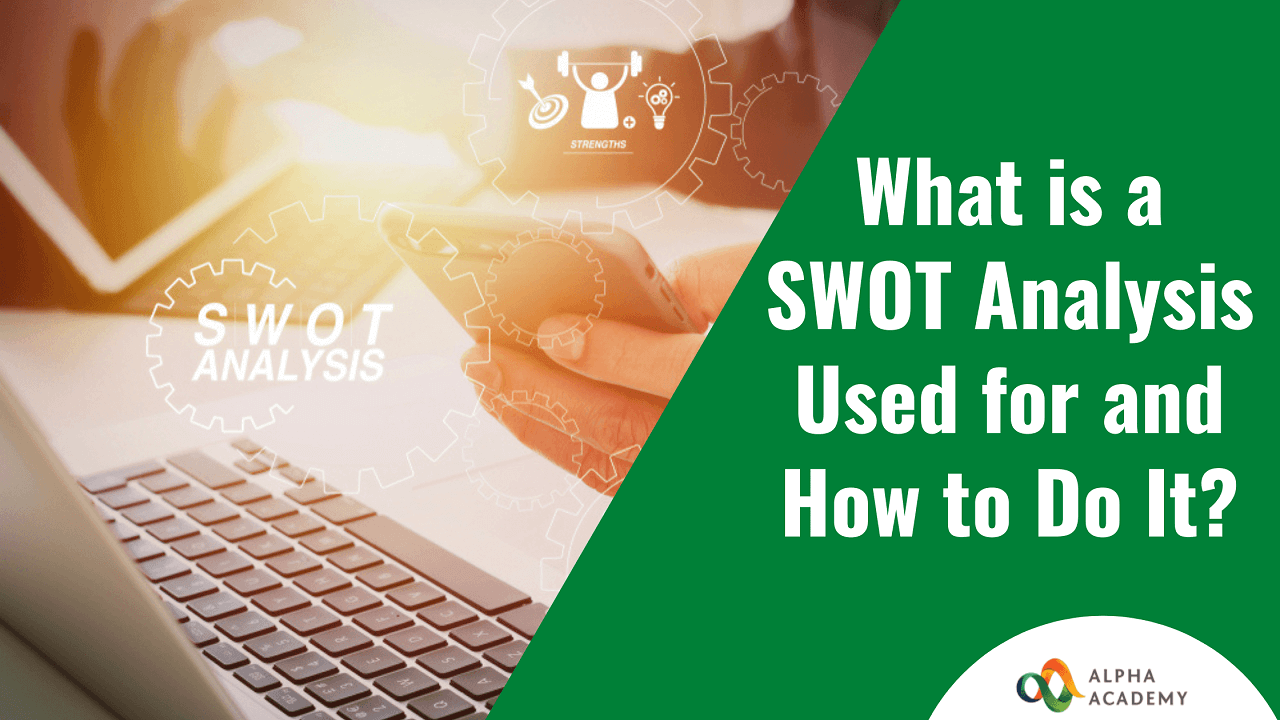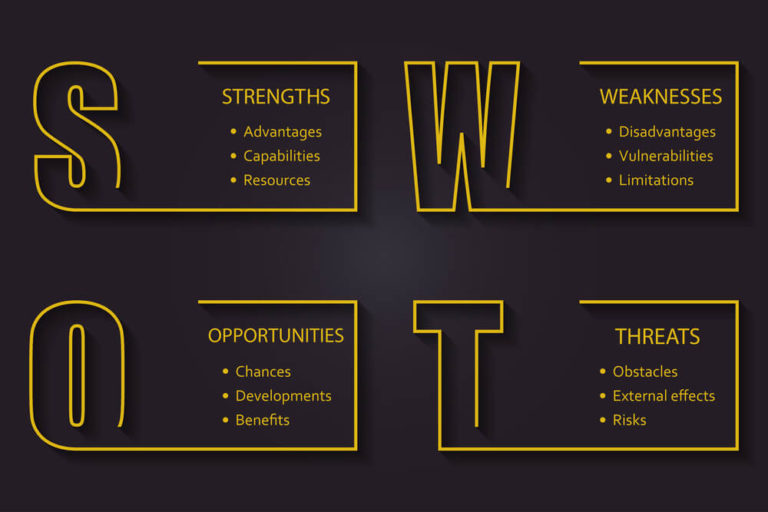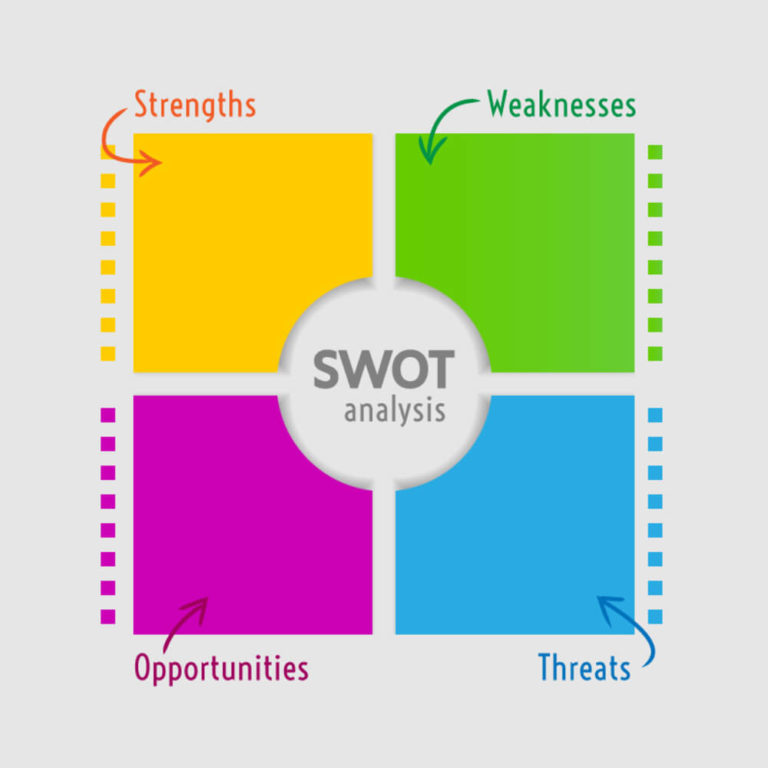
Do you want to assess and improve your organisation’s current position? Or see yourself in a top position of your company? If you’re thinking about where you want to go and how you might reach there – this blog is for you. We’ve got a powerful but simple tool for you to help you: SWOT Analysis. In this blog, you will get an in-depth understanding of what is a SWOT analysis used for and how to apply it in your professional and personal life.
Table of Contents
What is SWOT Analysis?
SWOT analysis is a technique for assessing various aspects of a business. Fundamentally, it assesses the performance, risk, and potential, competitor of a business as well as part of a business such as a product line or division, an industry, or other entity.

You can use this technical analysis to-
- Make the most of your resources
- Achieve goals and objectives of your organisation
- Reduce the chances of failure
- Craft a strategy that distinguishes you from your competitors and gain competitive advantages
- Increase efficiency and productivity
- Be successful in the market
And now you will learn how to do a SWOT analysis and use it for personal and professional development.
What does SWOT Analysis Stand for?
SWOT stands for strengths, weaknesses, opportunities, and threats. You might be curious about what is included in a SWOT analysis. Basically, SWOT analysis assesses these four aspects of your business. Also, this technique looks at internal and external factors that can affect your business.

Internal factors are your strengths and weaknesses. On the contrary, external factors are opportunities and threats.
Strengths
The first element of this SWOT analysis is Strength. So, as you might have already guessed, this element refers to things your company or project does incredibly well. On the other hand, it can be in a way that distinguishes you from your competitors. SWOT analysis will help you identify your business units that are performing well!

This can be something intangible. For example, your company’s brand attributes, or a unique selling proposition of a particular product line. Think about the advantages your organisation has gained over other companies. It can also be your-
- Skilled human resources
- Strong leadership ability
- A great technical team
- The motivation of your staff
- Access to certain materials/equipments
- A strong set of manufacturing machinery
- A strong brand image
- Loyal customer base
- Unique technology
Your company may have one or many of the above. Your strengths are what make your company successful. So, identify what’s the unique strength that gives you a strategic advantage. What is the fact that can make you exceptionally successful in the industry? What drives your business? Or, what unique yet low-cost resources can you use that others don’t have?
Firstly, identify and analyse your business’s Unique Selling Proposition and add this to the strong side. Then broaden your perspective and ask yourself what your competitors might consider as your strengths. What factors helped you to get the sale level ahead of them.
Weaknesses
After you figure out your strengths, it’s time to be critical and be self-aware of your weaknesses. What’s keeping your company or a project back from reaching its potential? Some examples of weaknesses are –
- Shortage of skilled human resources
- Financial or budgetary limitations
- A weak brand
- Higher-than-average turnover
- High levels of debt
- An inadequate supply chain
- Lack of capital

Weaknesses, like strengths, are one of the inherent features of your organisation. Therefore, focus on your employees, resources, procedures, and total system. Then, think about the scope of improvement and the things you should avoid.
Finally, find out how other people, especially your rivals in your market, think about you. Do they notice weaknesses that you are unaware of? Then, take some time to identify why your competitors are doing better than you. How are they doing better? Also, what are your company’s drawbacks?
Opportunities
The next one is Opportunities. An opportunity is a scope or chance for something positive to happen. However, you’ll need to work on it and claim it for yourself! For example, is your marketing team generating a high volume of leads? Is there an opportunity to generate more leads? Or, is your company’s RND (Research and Development) team developing innovative ideas for a new market or a new product? That’s another opportunity.

pportunities usually arise from situations outside your organisation. So, you have to be cautious and keep an eye on what might happen in the near future. For example, they might appear because of the developments in the market you are conducting business. Or, improvement of the technology you use would be your next opportunity. However, being able to spot and utilise opportunities can make the most significant difference to your organisation’s ability to compete and take the lead in the business industry.
In short, opportunities refer to favourable external factors that can give your company a competitive advantage. For example-
- If your country reduces business tariffs or taxes
- When a mobile phone manufacturer can export its phone into a new market without any barriers
- Favourable changes in government policy related to your company’s field
- Positive market trends
- Change in social patterns, lifestyles, and population profiles
Therefore, look for opportunities continuously. And be ready to exploit them! These opportunities don’t need to be game-changers, because small advantages can also increase your organisation’s competitiveness.
Threats
Threats indicate anything that can negatively affect your business from the outside. Therefore, it’s vital to anticipate them before you become a victim of threat and your growth falters.
Firstly, think about the obstacles you are facing in getting your product to market. Are you facing any issues while selling your products?. Also, you have to be sure to explore whether your organisation is significantly exposed to any external challenges. Is there any issue that can make you vulnerable to even small changes in the industry? Secondly, remember that technological change is an ever-present opportunity, as well as a threat!
Suddenly, you may notice that quality standards for a specific product are changing. So, you have to change and improve the product features beforehand to stay in the lead.

Threats are external factors that can create problems for your business, such as-
- Changes in the market that can negatively impact your business
- Competitor’s new advertising campaign
- Adverse government policy related to your field
- Supply chain problems
- Shifts in market requirements
- A shortage of recruits
- Bad debt or cash-flow
SWOT tool can help you identify threats. At the same time, it shows you ways to counteract them depending on your strengths and weaknesses.
Finally, always consider what your competitors are working on right now, if you should change anything in your organisation to meet the upcoming challenges. However, you do not need to copy others. Because what they’re doing might not be the right thing for you.
How to Do a SWOT Analysis?
After you are done sorting all the aspects of SWOT, you must have a long list of practical actions to take. Now, you’ll need to build on your strengths, work on your weaker zones, head off all your threats, and exploit any opportunity that comes to your door.
But, before you take further action, think strategically! For this purpose, look if there are any potential connections between the quadrants of your SWOT matrix. For example, if there are any of your strengths that can open up opportunities in the future? And if more options can be available to you by eliminating any of your weaknesses?
Now it is time to be prudent and prioritise your ideas. So, focus your time and money on the most significant ones. Refine and justify every point to make your comparisons clearer. For SWOT analysis, only accept precise and verifiable statements. Such as, “cost advantage of £15/ton by using medium quality paper (raw material)” rather than, “better quality of final product which may make profit £10/ton by using high quality paper (raw material).”
Creating SWOT Matrix
SWOT matrix is a straightforward tool to perform a systematic SWOT analysis. It has a 2×2 grid. It has one square for each of the four elements of SWOT.

Figure 1: SWOT Analysis
Gather a team from different departments and levels in your organisation. Then, brainstorm and make a list of ideas based on your company’s internal and external environment. So, when you can identify strength, weakness, opportunity, or threat, write it down in the part of the grid it fits. This is how to conduct a SWOT analysis.
Note: To make it easier, your organisation’s strengths, and weaknesses are internal factors. So, it is linked with the inner part of your business, like- its assets, processes, and people. On the other hand, opportunities, and threats as external factors. And, they arise from outer areas, like- your market, your current, and potential competitors, and the broader part of the economy.
What is a SWOT Analysis Used for?
Since we have developed a basic understanding of SWOT analysis, let us discuss what is a SWOT Analysis used for. And, many firms consider SWOT analysis an effective tool for analysing data and information. The simple framework provides a sense of direction and works as a catalyst for developing future plans and strategic objectives.
1. SWOT analysis provides an organisation with a clear view of its strengths. So, SWOT is a source of information for strategic planning, allows plans to build on them and meet business objectives.
2. It highlights and reverses its weaknesses.
3. It maximises its response to opportunities and showcases possible opportunities that lie in the future. This allows the organisation to draft strategic growth plans for the future.
4. SWOT fosters to overcome organisational threats. It helps an organisation recognise potential threats. Also, take necessary measures to deal with them one after another. For this, a firm can introduce new policies and establish growth plans to eliminate any upcoming threats.
5. It helps identify the core competencies of the firm.
6. SWOT analysis allows a company to create matching and converting strategies
7. Its analysis sheds light on the company’s existing resources which may have been ignored or have not been used to their full potential.
8. It helps in knowing past, present, and future so that future plans can be chalked out using past and current data.
9. SWOT analysis facilitates data that helps synchronise the firm’s resources and capabilities with the competitive environment in which the firm operates.
10. This process focuses on and boosts the skills, capabilities, attitudes, abilities, and capacities.
These are the reasons what is a SWOT analysis used for! If performed correctly, a SWOT analysis organises information and data and uncovers competitive advantages that a business can use to gain leverage over its competitors in the market.
What is a Personal SWOT Analysis?
After learning about organisational SWOT analysis and what is a SWOT Analysis used for, now you will get to know about personal SWOT analysis and development. You will understand how a SWOT Analysis can be used in your personal life.
Firstly, it is an essential step for making yourself more appealing to any recruiter and clients. Secondly, it will help to boost your self-confidence.
Pro Tips
If you want to secure the top position, you have to work hard and work smart. Individuals often conduct SWOT analysis for personal improvement.
Thus, let’s look at what is a SWOT analysis used for when making a personal SWOT
Personal Strengths
Consider finding strengths from your own perspective. Also, take the point of view of the surrounding people. Be as objective as you can, and don’t be modest or shy! Furthermore, detecting and utilising your strengths can make you more effective and successful at work.

You can ask the following questions to figure out your strengths –
- What advantages do you have over other people? What are your skills, certifications, education, or connections?
- Are you part of any network that your competitors aren’t involved in?
- What are you doing better than anyone else?
- What additional resources can you access that others can’t?
- What are your achievements?
- What do others, especially your team leader, see as your strengths?
- Is there any value you believe in that others fail to exhibit?
Afterward, note down your personal characteristics on a white paper if you still face difficulties identifying your strengths. You can also ask others for feedback.
Personal Weaknesses
While searching for weakness, consider the views from personal and other external perspectives. For example, do other people around you see weaknesses that you can’t? And, do your colleagues consistently outperform you in any aspect?

Make a list of questions that may help you find your weaknesses. Like-
- What tasks do you usually avoid because you don’t feel confident doing them?
- What do other people around you see as your weaknesses?
- Do you feel confident in your educational and other skills? If not, then what are your weakest sides?
- Do you have any negative work habits? If it is, what are they?
- Do you have any specific personality traits that hold you back in your profession?
Be realistic! It will be better for you to face any unpleasant truths as soon as you can. After all, this is what a SWOT analysis is used for!
Personal Opportunities
Your opportunities will come out by answering the questions following-
- Is the sector you are working on growing? If it is, then how can you be profitable in the current situation?
- How can you take advantage of the current trend of your office? What innovation can help you?
- Is the sector you are working on growing? If it is, then how can you take advantage of the current situation?
- Do you have any source to help you or offer you a piece of good advice?
- Do your competitors continuously fail to do something important? If so, is there any way you can take advantage of their mistakes?
- Is there a vacuum in your organisation or industry that no one is filling?
- Can you create an opportunity by offering a solution to a current problem to your customers or vendors?

Furthermore, you may get good opportunities in the ways mentioned below:
- Networking in the various workplace, events, or conferences
- Taking someone else’s projects to gain experience
- Learning new skills by continuous personal development
Moreover, look at your strengths, and figure out whether these can open up any opportunities for you! Likewise, look at your weaknesses, and ask yourself if they can open up new opportunities by eliminating weaknesses.
Personal Threats
After identifying opportunities, it is time to find out and treat the threats. For this purpose, ask yourself-
- What obstacles are you currently facing at the workplace?
- Are any of your co-workers competing with you for a position?
- Is your job sustainable?
- Is changing technological advancement a threat to your current role?
Performing this analysis properly will often provide key information on what threats you might face. Moreover, it will help you look for a solution by anticipating threats.
What is the Purpose of a SWOT Analysis as an Individual?
The fundamental purpose of a SWOT analysis is to promote your identified personal strengths, reduce your weaknesses, exploiting the opportunities that come to your door, and having contingency plans to minimise your threats. Also, there are many advantages and benefits of applying SWOT analysis for personal development. Most importantly, it can bring you the desired success by giving you pointers on what you need to improve and what opportunities can you utilise!

Nevertheless, here is a list of benefits of a personal SWOT analysis mentioned below-
- Develop effective plans to attain your objectives
- Pinpoint your current position towards the road to ultimate success
- Detect and enhance your skills
- Measure your scopes of reaching the desired destination
- Boost your personality, career as well as life
- Explore who you are as a person
- Understand your personality traits and preferences
- Focus on your skills, capabilities, attitudes, abilities, and capacities.
These are just a few. There are many other positive attributes of this analysis. Therefore, apply it wisely and enjoy the extraordinary advantages of personal SWOT analysis.
Conclusion
A SWOT analysis can continuously guide your business towards its goals. Also, it ensures your progress and success. The primary purpose of this article was to educate everyone on SWOT analysis and what is a SWOT Analysis used for. If you want to gather more information on this, learn the goal-setting strategies, and work on personal development!
Recent Posts
- Benefits of Taking Online Courses for Your Education and Career Growth
- 12 Optimum Ways to Compare & Set Proofreading Rates in Your Field
- Writing Marketing Copy
- Youtube Monitization Guide – How to Monitize Youtube Channel
- How to Get Promoted in 2024 – 8 Best Practices
- Project Management : Guide to Become a Project Manager
- How to Develop a Business Plan
- How Online Courses Are Changing the Education Landscape
- Unlocking Academic Success: The Role of Professional Assignment Help Services
- Choosing the Right Code Editor – Features to Look For











0 responses on "What is a SWOT Analysis Used for and How to Do It?"